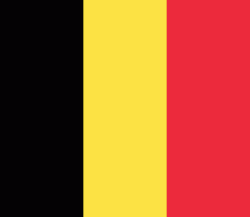Plantin-Moretus Museum (Museum Plantin-Moretus)
The Plantin-Moretus Museum (Plantin-Moretusmuseum) is a printing museum in Antwerp, Belgium which focuses on the work of the 16th-century printers Christophe Plantin and Jan Moretus. It is located in their former residence and printing establishment, the Plantin Press, at the Vrijdagmarkt (Friday Market) in Antwerp, and has been a UNESCO World Heritage Site since 2005.
The printing company was founded in the 16th century by Christophe Plantin, who obtained type from the leading typefounders of the day in Paris. Plantin was a major figure in contemporary printing with interests in humanism; his eight-volume, multi-language Plantin Polyglot Bible with Hebrew, Aramaic, Greek and Syriac texts was one of the most complex productions of the period. Plantin's is now suspected of being at least connected to members of heretical groups known as the Familists, and this may have led him to spend time in exile in his native France.
After Plantin's death it was owned by his son-in-law Jan Moretus. While most printing concerns disposed of their collections of older type in the eighteenth and nineteenth century in response to changing tastes, the Plantin-Moretus company "piously preserved the collection of its founder."
Four women ran the family-owned Plantin-Moretus printing house (Plantin Press) over the 16th, 17th, and 18th centuries: Martina Plantin, Anna Goos, Anna Maria de Neuf and Maria Theresia Borrekens.
In 1876 Edward Moretus sold the company to the city of Antwerp. One year later the public could visit the living areas and the printing presses. The collection has been used extensively for research, by historians H. D. L. Vervliet, Mike Parker and Harry Carter. Carter's son Matthew would later describe this research as helping to demonstrate "that the finest collection of printing types made in typography's golden age was in perfect condition (some muddle aside) [along with] Plantin's accounts and inventories which names the cutters of his types."
In 2002 the museum was nominated as UNESCO World Heritage Site and in 2005 was inscribed onto the World Heritage list.
The Plantin-Moretus Museum possesses an exceptional collection of typographical material. Not only does it house the two oldest surviving printing presses in the world and complete sets of dies and matrices, it also has an extensive library, a richly decorated interior and the entire archives of the Plantin business, which were inscribed on UNESCO's Memory of the World Programme Register in 2001 in recognition of their historical significance.
The printing company was founded in the 16th century by Christophe Plantin, who obtained type from the leading typefounders of the day in Paris. Plantin was a major figure in contemporary printing with interests in humanism; his eight-volume, multi-language Plantin Polyglot Bible with Hebrew, Aramaic, Greek and Syriac texts was one of the most complex productions of the period. Plantin's is now suspected of being at least connected to members of heretical groups known as the Familists, and this may have led him to spend time in exile in his native France.
After Plantin's death it was owned by his son-in-law Jan Moretus. While most printing concerns disposed of their collections of older type in the eighteenth and nineteenth century in response to changing tastes, the Plantin-Moretus company "piously preserved the collection of its founder."
Four women ran the family-owned Plantin-Moretus printing house (Plantin Press) over the 16th, 17th, and 18th centuries: Martina Plantin, Anna Goos, Anna Maria de Neuf and Maria Theresia Borrekens.
In 1876 Edward Moretus sold the company to the city of Antwerp. One year later the public could visit the living areas and the printing presses. The collection has been used extensively for research, by historians H. D. L. Vervliet, Mike Parker and Harry Carter. Carter's son Matthew would later describe this research as helping to demonstrate "that the finest collection of printing types made in typography's golden age was in perfect condition (some muddle aside) [along with] Plantin's accounts and inventories which names the cutters of his types."
In 2002 the museum was nominated as UNESCO World Heritage Site and in 2005 was inscribed onto the World Heritage list.
The Plantin-Moretus Museum possesses an exceptional collection of typographical material. Not only does it house the two oldest surviving printing presses in the world and complete sets of dies and matrices, it also has an extensive library, a richly decorated interior and the entire archives of the Plantin business, which were inscribed on UNESCO's Memory of the World Programme Register in 2001 in recognition of their historical significance.
Map - Plantin-Moretus Museum (Museum Plantin-Moretus)
Map
Country - Belgium
 |
 |
| Flag of Belgium | |
Belgium is a sovereign state and a federal constitutional monarchy with a parliamentary system. Its institutional organization is complex and is structured on both regional and linguistic grounds. It is divided into three highly autonomous regions: the Flemish Region (Flanders) in the north, the Walloon Region (Wallonia) in the south, and the Brussels-Capital Region. Brussels is the smallest and most densely populated region, as well as the richest region in terms of GDP per capita. Belgium is also home to two main linguistic communities: the Flemish Community, which constitutes about 60 percent of the population, and the French Community, which constitutes about 40 percent of the population. A small German-speaking Community, numbering around one percent, exists in the East Cantons. The Brussels-Capital Region is officially bilingual in French and Dutch, although French is the dominant language.
Currency / Language
| ISO | Currency | Symbol | Significant figures |
|---|---|---|---|
| EUR | Euro | € | 2 |
| ISO | Language |
|---|---|
| NL | Dutch language |
| FR | French language |
| DE | German language |















